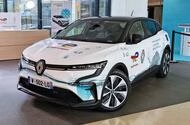New battery technology is making waves in the electric vehicle (EV) landscape, particularly with the Renault Megane E-Tech. Thanks to Total Energies Lubrifiants, this innovative vehicle has been fitted with an immersion-cooled battery that utilizes a groundbreaking fluid known as Cell Shield. The results? Charging times have been halved, and the vehicle’s range has seen a 6% boost. Let’s dive into what this all means and how it could shape the future of electric driving.
How Does Immersion Cooling Work?
At its core, immersion cooling is about reducing heat by submerging components in a fluid. While that sounds straightforward, it’s a bit more complex when it comes to electronics. For instance, introducing water to electrical circuits can lead to disastrous short circuits. That’s why EV batteries are designed to be waterproof.
In traditional combustion engines, heat is transferred through metal walls into water flowing through channels. This water then moves to a radiator, where it’s cooled by air. It’s a similar concept to immersion cooling, where heat is dissipated directly from hot components into a cooling medium.
In the realm of electronics, heat is typically managed by transferring it to the air or using heat sinks. However, immersing components in a dielectric fluid—one that doesn’t conduct electricity—offers a more efficient solution. This method has been used in power distribution systems for years, but its application in EV batteries is a relatively new frontier.
What Makes Cell Shield Special?
The challenge with immersion cooling lies in developing the right fluid. Total’s Cell Shield is designed to flow through battery cells without conducting electricity, allowing for direct heat transfer from the cells into the fluid. This not only enhances cooling efficiency but also simplifies the overall design of the battery system.
Interestingly, immersion cooling can lead to lighter battery packs since some of the traditional components used in liquid-cooled systems can be eliminated. This means that not only do we get better performance, but we also get a more streamlined design.
The Journey to the Megane E-Tech
Total Energies didn’t just stumble upon this technology overnight. The development of the immersion-cooled battery for the Megane E-Tech was the result of years of research and collaboration with British engineering firm Ricardo. Their work began with a prototype for a Volvo XC60 plug-in hybrid back in late 2020.
The findings were promising: immersion-cooled batteries not only provided superior cooling and faster charging times but also fit well within existing vehicle architectures. They were found to be 6% cheaper and lighter than traditional battery systems.
Safety is another critical aspect. The new fluid has shown remarkable capabilities in suppressing thermal runaway and internal fires, which are significant concerns in the EV industry. This advancement could lead to greater consumer confidence in electric vehicles, making them a more appealing choice for a broader audience.
What This Means for the Future of EVs
The implications of this technology extend beyond just the Renault Megane E-Tech. As manufacturers look to improve charging times and vehicle ranges, innovations like immersion cooling could become standard in the industry. Faster charging means less time at the charging station and more time on the road, addressing one of the biggest concerns for potential EV buyers: range anxiety.
Moreover, the lighter and more efficient battery systems could lead to a new generation of electric vehicles that are not only more powerful but also more environmentally friendly. With reduced manufacturing costs and improved safety, we might see a significant shift in how electric vehicles are perceived and adopted.
The big takeaway? Embracing innovations like immersion cooling isn’t just about enhancing performance—it’s about reshaping the entire landscape of electric mobility. If you’re considering making the switch to an EV, keep an eye on these advancements. They could very well change the game for electric driving in the near future.

